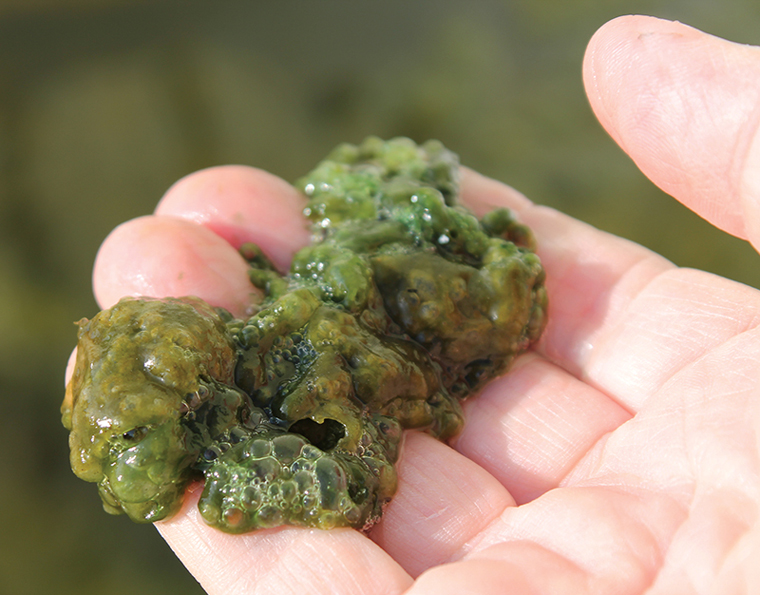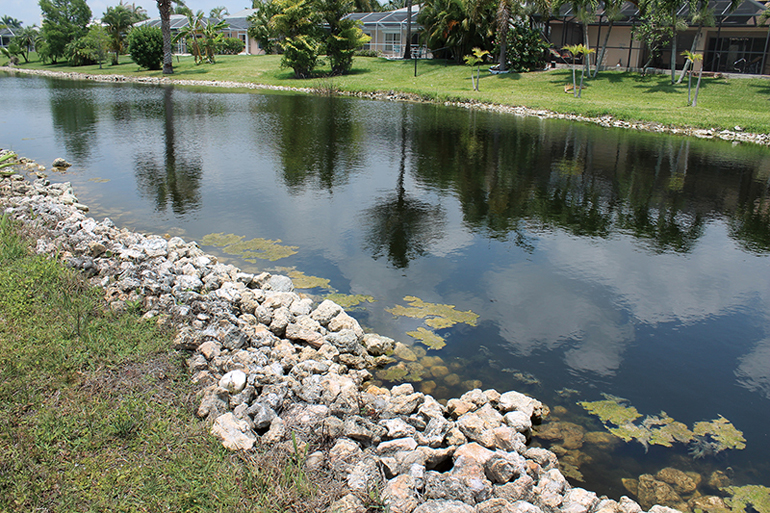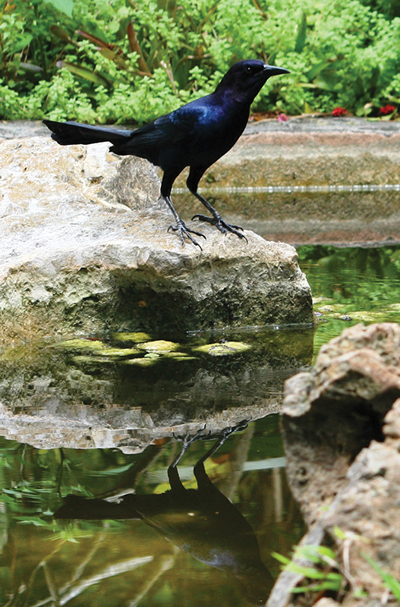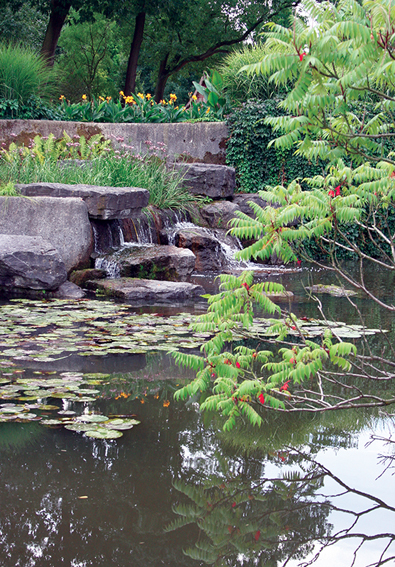
A common challenge we have all faced is finding a suitable way of removing algae in decorative fish ponds that will be safe for both fish and aquatic plants. For many years, ponds had come to depend upon copper-sulfate to clear green water and string algae in farm ponds. However, we soon learned that carp have a low tolerance level for copper, a heavy metal that can be toxic in low concentrations. Like other heavy metals, such as mercury, it is a bioaccumulation. This means that once it is ingested by an organism, it remains in that organism for an extended period, and in many cases, for life. Any additional ingestion will increase the level that is already present in the organism, eventually reaching toxic levels.
Interestingly, for terrestrial organisms, this level is determined primarily by the ingestion of food and water (i.e., by pets and other wildlife visiting the pond), but for aquatic organisms, if the copper is in suspension as ions, it may be ingested during the respiration process. This is exactly the case with fish, bacteria and other growth within the pond. In the case of fish, it causes increased mucus production on the body and gills, where it eventually interferes with the respiratory process by blocking the absorption of oxygen. The fish seem to die for no apparent reason, unless you examine the gills carefully using a microscope.
Killer Copper
After mercury, copper is the most toxic of the heavy metals. I found it interesting that copper’s toxicity level is greatly influenced by water hardness and pH. As hardness and pH increase, the toxicity of copper is actually reduced. Copper is extremely toxic to most invertebrates and the juvenile forms of most amphibians.
This subject was studied in the July 2007 issue of the Journal of Environmental Toxicology and Chemistry. “Northern leopard frogs (Rana pipiens) were exposed to environmentally relevant concentrations of copper in water (control and 5, 25 and 100 mcg/L, as CuSO4) in a static renewal system for 154 days from post-hatch state to metamorphosis. Tadpole survival, swimming performance, percent metamorphosis, time to metamorphosis and survival during and time required for tail resorption were negatively affected in the 100-mcg/L treatment.” (Chen, et. al.)
Available toxicity data on amphibians indicate that copper 96 h LC50 values calculated in tadpoles ranged from 0.04 to 5.38 mcg/L. Studies of other aquatic organisms show 96 h LC50 values ranging from 0.06 to 6.68 mcg/L. Representative toxicity levels for most snails is 8 to 41 mcg/L; for Cladocerans (including Daphnia) is 5 to 213 mcg/L; and for amphipods 8 to 87 mcg/L.

Although the mayfly is fairly sensitive to copper, the majority of insects that have aquatic larval stages are tolerant — most notably damselflies and dragonflies, which are expected visitors at any aquatic installation. These odonates can store heavy metals in their exoskeletons, where it remains harmless.
The inhibition, reduction or elimination of any member group of the aquatic food chain will have definite, negative effects on the overall health of the ecosystem to a lesser or greater degree, depending on which species are residents of that particular ecosystem and their relative positions in the food web. Nevertheless, any negative effect on an aquatic ecosystem’s food chain or diversity will have deleterious effects on the entire system.
Introducing Polyquat
Polyquat is a more ecofriendly algaecide and completely biodegradable in the environment. It is not a bioaccumulation, and when used appropriately, it will not cause increased slime production. Polyquat can be used in solutions up to 5.4 percent and is safe for fish and plants.

However, in order to remain safe for fish and desirable aquatic plants, an algaecide can only be 80 percent effective. This is why we call it algae control rather than algae elimination. The rest of the job rests on the shoulders of the pond maintainer.
It is a chemical, so precautions are necessary. Fish could die from an overdose if too much of the chemical is added to the pond. Either an incorrect measurement of the pond’s volume or an incorrect dosage added to the pond at time of application can be fatal. Don’t guess.
Polyquat can also be dangerous if there is inadequate circulation at the time of application. Though this generally will not cause fish death, it can cause burns if the application allows hot spots to occur in the pond.
Similarly, hot weather with high fish volume and heavy algae growth can create a precarious situation. The removal of algae would result in increased organic waste that spikes biological oxygen demand to biodegrade the dead algae. This can result in reduced availability of dissolved oxygen for fish. The largest fish usually die in the early hours of the morning, because oxygen levels are lowest due to the lack of photosynthesis and the increase of oxygen consumption by plants and fauna over the course of the night.
What About Bacteria?
According to an April 2016 article in the Chemical Engineering Journal: “The nitrifying bacteria are of great concern to ponds. The results of studies on the toxic effects of copper are quite surprising. Copper at low levels actually stimulates activity in Nitrobacter. At levels up to 0.50 mcg/L, the copper ion has no toxic effect on Nitrobacter. Instead, the stimulatory effect is readily apparent.
Well, this is not true of Nitrosomonas! The growth of Nitrosomonas is greatly inhibited (about 60 percent) by copper concentrations of 0.20 ppm.” (Skinner & Walker)
Using microscopic observation here at Ecological Laboratories, we found that at normal and double the application rate, bacterial activity was not noticeably impacted by the polyquat algaecide. When applied to the pond, bacteria tend to attach themselves to any surface area and create a biofilm to protect themselves from any harmful changes and conditions in the environment. However, it is recommended to allow time between the bacterial and polyquat applications.
So, we have concluded that at these dosages, the effect on heterotrophic and autotrophic bacteria is minimal to slightly observable and not sufficient to eliminate or damage existing bacteria in a pond. On the other hand, when polyquat and bacteria are added to the pond simultaneously, the polyquat will, by nature, totally surround each bacterium in the water column.
How Does Polyquat Work?
According to the patent issued for polyquat algaecide, “the polymeric poly-electrolytes as disclosed herein are not only very effective algaecides but, in addition thereto, are substantially nonfoaming and nonirritating. They are particularly useful in such diverse applications as the control of algae in cooling towers, holding ponds, swimming pools and similar applications where an algaecide having such properties is mandatory, or at least desirable.”

It was the natural next step for adaptation and usage of polyquat algaecides in decorative and fish ponds, since algae growth is the top complaint from consumers. As the name implies, it is a polymer-based chemical that is short-lived but enwraps the life forms in the aquatic environment. At a concentration rate of up to 5.4 percent, aquatic plants and fish are not affected, but algae have a different cell structure. The wrap will completely cover the stems and leaves of algae, limiting oxygen and gas exchange and making it unable to extract nutrients. Generally within 24 to 48 hours, the algae plants will die. Polyquat is 100 percent biodegradable in the application time frame and can be reapplied as per the label.
That’s the good news. The danger of using polyquat algaecide is only in misjudging the dosage or creating hot spots when adding it to the pond. It is important to follow the directions on the label, because too little will not achieve the desired results, and adding too much may create a condition where the fish become targeted by the polyquat. In the absence of sufficient algae, the polymer will wrap the fish’s gills and cut off their ability to breathe properly.
Proportionally, it will attach to whatever is providing the most surface of the correct charge, whether it is algae, bacteria, sediments or something else. It will attach to bacteria at about the same speed at which it attaches to algae. Less of it attaches to bacteria, because if there is a lot of algae and sediment, there is less surface area competing for the polyquat’s attention.
It is not a situation where one is preferred over the other, and the polyquat won’t attach to bacteria until all the algae is gone. It’s like spraying the side of a house with windows. More water will be on the siding than the windows, simply because there is proportionately more surface area of siding, not because the water has any preference for siding over windows.
Read the Label
The active ingredient in two of the most popular polyquat algaecides today is Poly [oxyethylene (dimethylimiunio)-ethylene (dimethyliminio)-ethylenedichloride]. These are EPA-registered products. Any chemical that contributes to the elimination of a living entity (in this case, algae) must be registered with the EPA. The EPA issues the caution not to use polyquat algaecide with crustaceans, including shrimp, crabs and lobsters. The active chemical interferes with the production of chitin, which will weaken their external defense. Polyquat is not approved for use with fish intended for human consumption. The FDA, not the EPA, must authorize and approve anything intended for human consumption.
There is also a caution on the label not to use the algaecide without adequate aeration. Polyquat algaecide is not an oxygen-grabber. Algae are oxygenating plants. If the pond has sufficient algae growth to warrant treatment, you will be removing the oxygen producers and creating a sudden increase in organic waste. Therefore, there will be an increase of oxygen usage in the pond.
Naturally, there is always an assumed responsibility of the user when any chemical is added to the pond. Directions must be followed, and dosages must be accurate. The pond volume leaves little room for inaccuracies. But, there is no half-life for this chemical, and it contains no heavy metals. It does not eliminate the beneficial bacteria from the pond, and that which may be harmed has shown that it will quickly recover. And, since it will completely biodegrade in the pond and doesn’t have the toxicity potential shown by copper-based products — causing them to die suspiciously from no apparent cause — polyquat algaecides are cleaner and safer for the pond and our environment, hands down.



This article was excellent and gave good information on how this chemical works and effects my ecosystem. Thank you